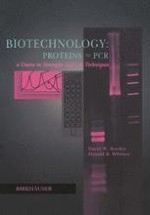
1995 | OriginalPaper | Buchkapitel
Introduction to the Biotechnology Laboratory
verfasst von : David W. Burden, Donald B. Whitney
Erschienen in: BiotechnologyProteins to PCR
Verlag: Birkhäuser Boston
Enthalten in: Professional Book Archive
Aktivieren Sie unsere intelligente Suche, um passende Fachinhalte oder Patente zu finden.
Wählen Sie Textabschnitte aus um mit Künstlicher Intelligenz passenden Patente zu finden. powered by
Markieren Sie Textabschnitte, um KI-gestützt weitere passende Inhalte zu finden. powered by
Introductory biology texts often present the biologist as a naturalist, such as Darwin or Lamark, who through careful observations develops theories and draws conclusions about living organisms. Originally these scientists kept biology and its subtopics as pure areas of study and resisted the multidisciplinary nature of modern science. For instance, in the 1830s Cagniard de Latour and von Liébig argued that fermentation was a biological phenomenon, not chemical. At this time biochemistry had yet to evolve, and the notion that biology and chemistry overlapped had not been fully realized. As the biology of the cell was discovered, several different scientific disciplines found it necessary to communicate in order to answer questions. In 1953, for instance, the structure of DNA was elucidated only after Watson and Crick pooled the information produced by biologists, chemists, and physicists. Since that time, the various scientific disciplines have continued to actively interact. However, it wasn’t until the 1970s and 1980s that biology and business wholeheartedly converged to produce today’s biotechnology industry.Although biotechnology has existed for many years (e.g., the baking and brewing industries, and the microbial production of enzymes and vitamins), the explosion in interest and investment seen during the 1980s was unparalleled.Science has become highly interdisciplinary, and, consequently, scientists require a diverse array of skills to accomplish their research. Where once a biologist might have relied on visual observation of an organism for a behavioral study, today the same research could combine visual observations with molecular techniques. It is commonplace to see a biochemist relying on recombinant proteins for analysis, a molecular biologist on a computer for data analysis, and a microbiologist on a DNA sequence for the detection of a pathogenic microorganism. Unfortunately, these disciplines are often segregated in the classroom, and true integration does not occur until graduate research. Similarly, in industry the narrow focus of research technicians will often prevent their exposure to or participation in duties outside of their immediate job responsibilities.Our goal is to remove the barriers between scientific disciplines and to demonstrate the diverse techniques and strategies used in the biotechnology laboratory. To accomplish this, you will weave through a series of interrelated experiments designed to mimic the discovery process. The discovery process in this manual will focus on purifying and characterizing a protein and then cloning its associated gene. This manual will not only act as a source of techniques and methods involved in protein and nucleic acid research, but it also will serve as a reference and describe the research process itself.The initial experiments presented in this first chapter will involve the common techniques of media preparation, handling and observation of yeast and bacteria, and the culturing of yeast for protein production. These exercises will lead directly to subsequent experiments on the purification and characterization of the enzyme α-galactosidase.